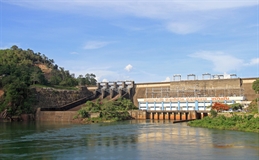
Non-governmental organizations are urging the shipping industry to pay attention to changes in Asia’s rivers.
Rivers throughout the region are being impacted by a number of issues which affect their flow, such as hydropower dams and sand mining.
Dams are often sold as good for navigation, as the reservoirs they create make navigation easier, and make up for having to go through sluices to pass the dam. This is the view being promoted by China, which also happens to be sponsoring the building of a cascade of dams along the Mekong River in Laos.
“Thanks to the reservoirs’ water supplement during the dry season, ships could navigate the upper and middle reaches of the Mekong River, where the water is shallow and shoals scatter, for the first time,” Yang Yang, a spokesperson for the Chinese Embassy in Thailand, told the Bangkok Post.
The trouble is that such a view reduces rivers, which are quite complex entities, to being like giant water pipes, which they aren’t.
Taking sediment, which rivers move, into consideration, dams often cause sediment starvation downstream, leading to incision of the river bed, which can then affect navigation, said Marc Goichot, lead water programme advisor at WWF Greater Mekong, at a recent event at the Foreign Correspondents’ Club of Thailand (FCCT).
Given the plans for dams on the Mekong, this is going to be a big, big issue in the future in Southeast Asia – and possibly further afield.
Stopping sediment, though, can either be seen “positively, by removing sand banks that cause water to be too shallow, or negatively, by [exposing] more rock outcrops,” Goichot told Asia Cargo News.
An example comes from one of the most cargo-traversed rivers there is: the Rhine in Europe. After a 13-metre drop of its river bed, the Istein bar “became a nightmare for navigation,” he said. Now, river managers bring barges with coarse sediment to replenish the river, which Goichot called a “very costly” project.
Other impacts include change of width and to a river’s sinuosity – its ability to curve or bend – which can also affect navigation, he added.
Rather than having others making decisions and navigation having to adapt, what’s needed, according to Goichot, is to take a “more integrated approach to planning river infrastructure, and not assume dams will have positive outcomes, but demonstrate that this will be the case.”
This is going to be difficult. The Rhine is well-managed by the nations it moves through, who also tend to coordinate well, a precedent yet to be set in Asia. There are also questions about who should run river infrastructure, Leonie Pearson, senior research fellow at the Stockholm Environment Institute, told attendees of the FCCT event.
“Water diplomacy needs to coordinate more,” said Carl Middleton, associate professor at Chulalongkorn University, who teaches environmental policy.
The benefits of such an approach could be huge, as the Mekong is hard to navigate, especially upstream of Kratie, and improving navigation between southern China and Thailand remains questionable, despite the need to open southwest China to a seaport, Goichot told ACN.
The Irrawaddy, another river where better navigation is needed for economic development, is another option to open western China to the sea, but it has its own set of problems.
Navigation of the Irrawaddy is difficult because the river bed in the middle slopes little but carries a lot of sediment from tributaries. As a result, the river shifts in terms of channel change, shape and sinuosity, and navigation is complicated – something which is aggravated by deforestation and mining.
Governments are investing large amounts in dredging, acknowledged Goichot, but that is only way to deal with the situation. “Again, this call for more integrated planning, and not only seeing rivers as water pipes, but also considering sediment, is key.”
Nor is that the only problem with sediment, or the lack of it. There is also shoreline change to factor in. This is a particular concern in Vietnam’s Mekong Delta, largely because of what is termed sediment starvation, which causes deltas to sink and shrink, according to Goichot. Vietnam may notice it first but it’s potentially a problem for China, too. And it’s also global.
“All low-lying sedimentary coasts will be affected,” Goichot said. “China has 30%-plus of its GDP in the sinking deltas of the Yangtze and Pearl rivers, thus a lot to lose. The BRI is also going to be landing in many Asian deltas. The impact on the Mekong Delta is not a small issue. It is estimated that half of the Mekong Delta will be under water by 2100.”
That’s a lot of land, industry and people to lose.
By Michael Mackey
Southeast Asia Correspondent | Bangkok




